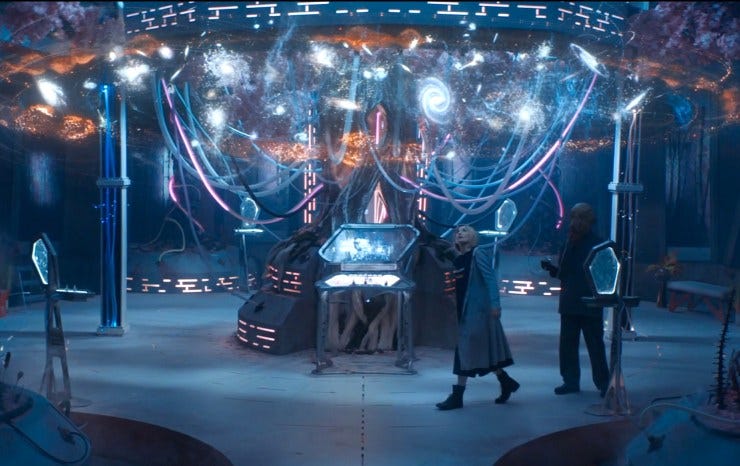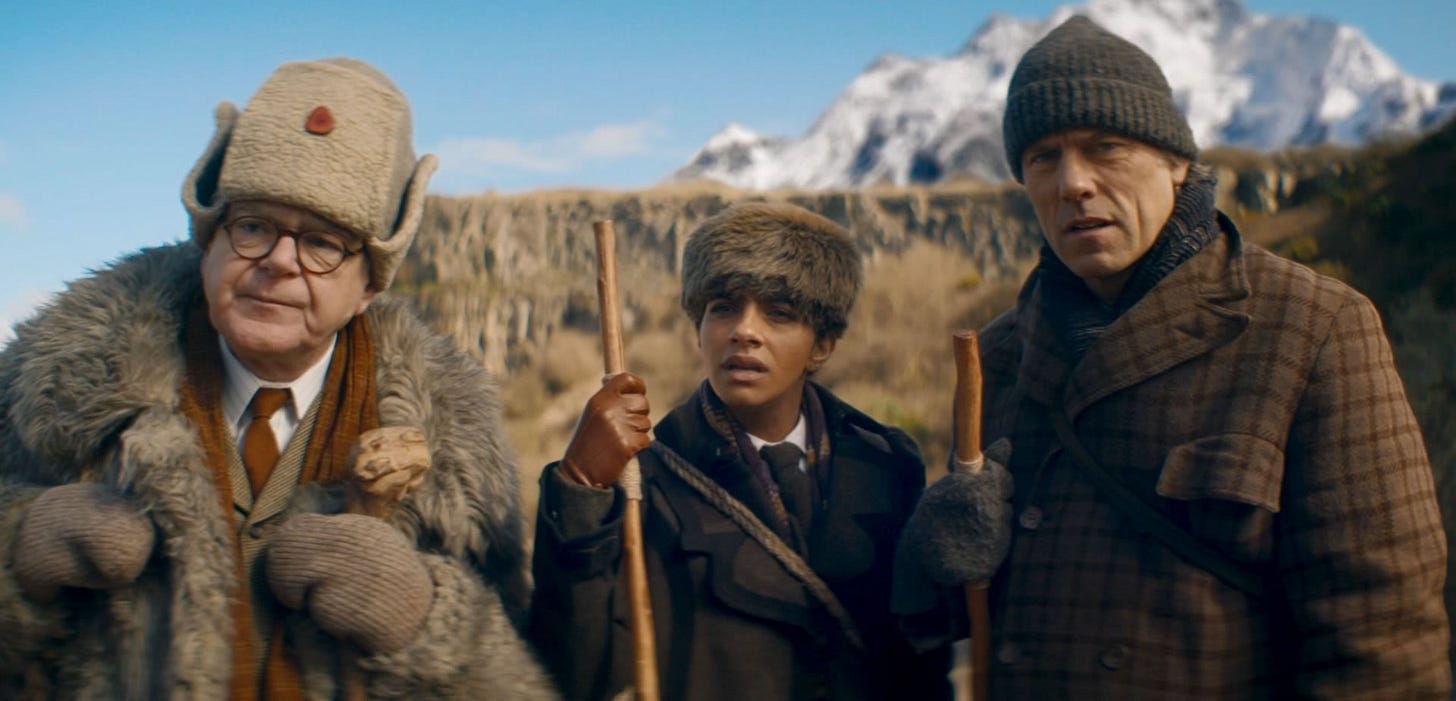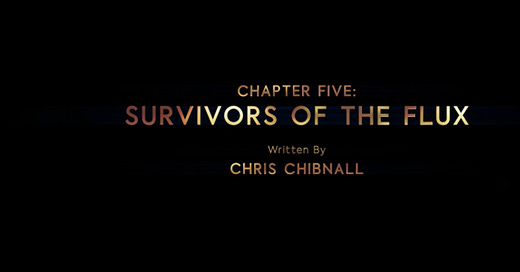Staying Alive
“Survivors of the Flux” gives Doctor Who fans reasons to worry and to rejoice.
Doctor Who: Flux
“Chapter Five: Survivors of the Flux”
Series 13, Episode 5
Written by Chris Chibnall
Directed by Azhur Saleem
Starring Jodie Whittaker, Mandip Gill, and John Bishop
Guest Starring Nadia Albina, Jacob Anderson, Robert Bathurst, Kammy Darweish, Craige Els, Barbara Flynn, Thaddea Graham, Kevin McNally, Steve Oram, Craig Parkinson, Jemma Redgrave, Rochenda Sandall, Sam Spruell, and Jonny Mathers
50 minutes
Original broadcast 28 November 2021
1. Good Enough?
After the thrilling manner by which Chapter Four of Doctor Who: Flux, “Village of the Angels,” propelled New Who’s Series 13 forward, perhaps its follow-up episode, “Survivors of the Flux,” could only disappoint audiences despite writer and showrunner Chris Chibnall’s best efforts. Given how engaging this installment is, “Survivors of the Flux,” if taken on its own terms, is a fine-enough entry in Flux’s ongoing narrative.
That last statement may sound like damning Chapter Five with faint praise, yet such a response seems inevitable given the high bar set by Chapter Four, particularly its sensational climax, which sees the Thirteenth Doctor (Jodie Whittaker) transform into a Weeping Angel. “Survivors of the Flux” probably never could scale (much less surmount) this dramatic summit, so judging Flux’s fifth chapter by its predecessor’s glories may be fundamentally unfair. Chibnall, to his credit, doesn’t attempt similar gut-punching moments in “Survivors of the Flux” because the showrunner knows he cannot surpass Chapter Four’s achievements and, wisely, chooses not to try.
The trouble, if trouble there be, comes in the unavoidable crashing to ground level that reaching this peak mandates. Chibnall doesn’t cushion Chapter Five’s fall, either, by assigning it the plainest title of the serial’s six episodes. “Survivors” would be more evocative, while “Wayfarers” would better encompass the globetrotting nature of an entry that, as usual, features terrific performances from everyone involved—especially principal cast members Whittaker, Mandip Gill (as Yasmin “Yaz” Khan), and John Bishop (as Dan Lewis)—alongside startling revelations about the Doctor’s hidden history as both the Timeless Child and as a member of the mysterious temporal black-ops agency called Division.
Chibnall, to boot, includes some marvelous jokes in a packed-to-the-rafters episode that takes its audience around the world and into many different time periods, thereby breathlessly grafting the conventions of the breeziest adventure narratives (H. Rider Haggard’s 1885 novel King Solomon’s Mines, director George Stevens’s 1939 film adaptation of Rudyard Kipling’s Gunga Din, and the Indiana Jones movies are clear reference points) to the disaster-movie tropes that Chibnall cherishes (and that longtime viewers know have typified Doctor Who since 1963).

2. Smart Enough?
With so much going for it, “Survivors of the Flux” is better than the fair-to-middling entry that some commentators have proclaimed,1 but Chibnall’s need to track so many different characters through so many separate places and times offers us reason to worry that he won’t be able to bring Flux to a gratifying conclusion. Why not? The answer involves Chibnall’s decision to put enough material in play to fill a normal 10- or 13-episode season. Chapter Five’s density makes me suspect that Chibnall, for all his talents, doesn’t have sufficient narrative real estate to build out the complicated edifice that Flux has become.
Due to COVID-19 filming restrictions, only six chapters were available to tell Series 13’s story, meaning that Chibnall may have miscalculated Flux’s overall trajectory by letting his enthusiasms run away with him, whether for crissing and crossing and combining as many genres as possible, for speculating philosophically about the contradictory nature of time itself, or for making the Doctor’s life the center of not simply Gallifreyan society but, indeed, the universe itself.
Such efforts should be applauded because, for me, writerly ambition is always preferable to its opposite. Too many fictional stories—whether in print, on stage, or on screen (of any size)—remain wedded to false notions of realism, probability, and plausibility, so Chibnall’s preference for pushing himself and his New Who scripts past the point of believability, sensible structure, and narrative propriety is, in the main, refreshing.
Doing so, in a compensatory benefit, harmonizes with Doctor Who’s long history of telling barmy stories that don’t always add up (at least in terms of plot), but that offer admirable wit, insight, humor, and emotional depth. As showrunners Russell T. Davies and Steven Moffat demonstrated in their gonzo approaches to the Doctor’s journeys throughout space and time, no single correct way to tell a Who story exists. From this vantage point, Chibnall’s decision to go for broke in Flux has already yielded better returns than playing it safe would have.
Following this path, however, courts real danger, especially if Chibnall cannot control Series 13’s runaway-train momentum enough to construct a conclusion that, even if it needn’t tie up every loose end, must knit enough of these hanging threads together so that viewers will find the tapestry satisfying to contemplate. The voyage, once concluded, must seem worth taking or Flux’s audience will feel cheated. Some fans, of course, will be unhappy no matter what Chibnall does, but the British Broadcasting Corporation’s (BBC’s) Flux advertisements promise “one epic story over six thrilling chapters,” so aiming for this goal is Chibnall’s chief challenge now that Flux has entered its final stretch.
As “Survivors of the Flux” makes clear, Chibnall’s chances of success seem high enough, but aren’t guaranteed.

3. Will People Like Thee?
Chapter Five, to state the matter plainly, moves at such a blinding pace that this installment cannot help but fling mind-bending ideas at viewers in a rushed narrative that, like Chapter One (“The Halloween Apocalypse”), risks becoming a plot engine that, rather than telling a rich story, mechanically slots all the necessary events, characters, and themes into their correct configurations to make way for next week’s concluding chapter, “The Vanquishers.”
Chibnall doesn’t skimp on cramming incident after incident, event after event, and revelation after revelation into “Survivors of the Flux.” He picks this episode up immediately after the remarkable final moments of “Village of the Angels.” The Thirteenth Doctor, now transformed into a Weeping Angel and recalled to Division, finds herself standing in a field of thousands of Angels before awakening inside a strange space station, where an Ood hands her a device called a “conversion plate” to stabilize her existence between dimensions.
The Doctor then meets a woman named Awsok (Barbara Flynn), whom she briefly encountered in Flux’s third chapter (“Once, Upon Time”) during the “time storm” that was that outing’s central plot point. Awsok reveals that she is, in fact, the latest regeneration of Tecteun, the mother of Time Lord society who, eons ago and on an unnamed planet, discovered the Timeless Child abandoned near a portal that formed the entrance to a wormhole.
Tecteun, soon realizing that this youngster could renew her physical form when near death, began studying this ability by provoking multiple regenerations in the Child until she (Tecteun) uncovered how this process works. Tecteun then injected the appropriate genetic markers into herself and created the first Gallifreyans capable of regeneration. Awsok/Tecteun, indeed, confirms as true everything that Sacha Dhawan’s vengeful Spy Master tells the Doctor about the Time Lords’ origins in New Who’s Series 12 finale, “The Timeless Children.”
She also confesses that Division was originally established to protect Gallifrey from external threats, but grew in authority and influence until it became large enough to recruit operatives from all species, eras, and even dimensions. This development allowed Division to begin contravening official Time Lord policy by interfering in how history unfolds, a power that unsurprisingly went to the heads of Division’s leaders, who claimed the right to engineer historical outcomes as they pleased, not merely by directing the course of entire worlds’ development but, as Awsok’s words imply, by exterminating entire species that didn’t meet Division’s standards for enlightenment. The Doctor, in a moment of sickened recognition nicely played by Whittaker, realizes that her personal history—the memories of which Division erased—is indirectly responsible for these outcomes.
Awsok, moreover, says that Division grew so weary of the Doctor’s travels throughout space and time that its leaders came to consider her a “virus [let] into the experiment” of the universe’s unfolding. The Doctor’s constant—albeit unknowing—interference with Division’s plans caused these same leaders to decide that the entire experiment had failed. They designed the Flux to destroy what Awsok calls Universe One—our universe, the whole of known creation—from their space station, located in the Void (i.e., the emptiness between dimensions).
Awsok and her Ood assistant are moving the station into a neighboring universe (dubbed “Universe Two”), which just happens to house the other end of the wormhole under whose entrance Tecteun first discovered the Timeless Child. Universe Two, in other words, may be the Doctor’s true home, but this notion barely registers before Awsok lets loose one final truth. Division created the Flux to destroy Universe One because the Doctor’s moral behavior, according to Awsok, contains the dangerous power to “inspire, make people question and rise up. You give them hope. That can be problematic.”
The Doctor is properly thunderstruck that Division created the Flux to stop her, thereby committing genocide on the largest-possible scale. Chibnall, in these scenes, refuses to play it safe, painting his creative ambitions on the broadest-possible canvas, so we should be thankful that Jodie Whittaker’s and Barbara Flynn’s good acting brings to life what might have been the staid sight of two characters lobbing information at one another. They transform Chibnall’s long passages of challenging dialogue into a conversation that, crackling with wit, is equal parts interrogation and verbal punching match. Both performers plumb emotional nuances (including wonder, surprise, regret, and even disgust at the other’s refusal to see the proper point of view) that might otherwise descend into maudlin sloganeering.
Director Azhur Saleem mixes beautifully composed close-ups of Whittaker’s and Flynn’s faces with long tracking shots and jump cuts that infuse this sequence with energy. Adept as Saleem is at realzing this section of Chibnall’s script, the storyline just summarized could have (and perhaps should have) filled Chapter Five’s 50-minute running time. Yet it exists as one of not two, not three, not four, but five distinct narrative threads whose presence in a single episode rouses my suspicions that Flux’s many parts may, in the end, overwhelm its whole.

4. Fair Do’s
“Survivors of the Flux,” for those readers still counting, also tracks Yaz, Dan, and Kevin McNally’s delightful Professor Eustacius Jericho as they roam the face of the Earth, in the year 1904, searching for evidence of when the world will end (meaning, when the final Flux event will destroy the planet). How they have sustained this adventure for three years, ever since being transported by the Weeping Angels to Medderton, England in 1901, to say nothing of how they can afford journeying via ocean liner from Mexico to Constantinople to Nepal to the Great Wall of China to Liverpool, England on a quest given them by an “adaptive hologram” of the Doctor, is anyone’s guess.
The Nepal sequence features a fabulous guest turn by Kammy Darweish as Kumar, a “legendary seer” whom Jericho wishes to consult to receive an important message about the date of Earth’s final hour, but who, living high atop a mountain, teases the three wayfarers for not bringing him news and gossip of the wider world. “What about some food? A rope? A pot? The latest Conan Doyle?” Kumar asks in fun and funny moments that Darweish winningly plays with mock indignation and joie de vivre. Kumar’s message contains only three words, “Fetch your dog,” which connects this second plotline to Chapter Five’s third narrative branch, namely the efforts of Lupari warrior Karvanista (Craige Els) to prevent breaches in the planet-encompassing shield that his species’s seven-billion spacecraft formed around Earth (in “The Halloween Apocalypse”) to protect it from the Flux’s shockwave.
Karvanista does so by recalling the stolen Lupari craft that Bel (Thaddea Graham) commandeers in “Once, Upon Time,” which we last saw in “Village of the Angels” when Bel landed on the planet Puzano searching for—you guessed it—survivors of the Flux, only to encounter villainous sibling Azure (Rochenda Sandall) telling the refugees who had found their way there that she’ll transport them to a new paradise away from the Flux’s death and destruction. Azure instead traps these poor souls in what she calls a Passenger form, a humanoid character (played by Jonny Mathers wearing a metal mask) first encountered in Chapter Three that is, in fact, a living container whose endless interior space is perfect for incarcerating prisoners.
Karvanista takes remote command of Bel’s ship and returns it to Earth, only to have Bel excoriate him for stopping her quest to find her partner (and the father of her unborn child), Inston-Vee Vinder (Jacob Anderson), who finds himself trapped inside Passenger after he arrives at a giant monolith built on an asteroid in deep space, where Azure and her brother, Swarm (Sam Spruell), disintegrate the Puzano refugees and harvest the resulting energy to power their trip across dimensions in hopes of reaching the same Void space-station that houses the Doctor and Awsok.
And if this fourth subplot doesn’t satisfy your thirst for more, more, more! Doctor Who action, please know that Chris Chibnall’s narrative cup runneth over into a fifth storyline that sees Craig Parkinson’s Grand Serpent—the interstellar despot first seen in “Once, Upon Time” (and the person responsible for Vinder’s exile to Observation Outpost Rose)—appear in England, circa 1958, masquerading as a man named Prentis who crosses paths with General Farquhar (Robert Bathurst), the man assigned by the United Nations to build the British branch of a global task force that will investigate and counter extraterrestrial threats to Earth.

Yes, friends, Chibnall here takes “Survivors of the Flux” right back to the founding of UNIT, the alien-fighting organization first seen in the 1968 Second Doctor (Patrick Troughton) serial The Invasion. Named the United Nations Intelligence Task Force in that adventure and throughout its appearances in Classic Who, UNIT came to prominence during Jon Pertwee’s 1970-1974 run as the Third Doctor, remaining part of onscreen Who until 1975-1976’s Season 13, after which it made one final appearance in the 1989 Seventh Doctor (Sylvester McCoy) adventure Battlefield (notably, the opening serial of what proved to be Classic Who’s final televised season).
Russell T. Davies introduced UNIT (renamed the Unified Intelligence Task Force) to New Who during its first two-parter, Series 1’s 2005 Ninth Doctor (Christopher Eccelston) installments “Aliens of London” / “World War Three.” Chibnall’s inspired choice to show how UNIT gets going in “Survivors of the Flux” sees Prentis/the Grand Serpent infiltrating the agency from the moment of its founding, which permits him to organize its structure over the next nine years.
General Farquhar, while touring UNIT’s new Ministry of Defence headquarters one day in 1967, unwisely decides to scan Prentis with a device that detects extraterrestrial life signs, causing Prentis to murder Farquhar by summoning a long, spiked, snakelike creature that suffocates Farquhar from within. Farquhar’s face ripples grotesquely to announce this critter’s presence, which then exits his mouth and merges with Prentis’s body in images that show just how good New Who’s visual-effects team is.

5. Fair Warnings
Chibnall gives longtime viewers two added treats in Chapter Five’s UNIT scenes. First, while Farquhar leads Prentis through UNIT’s freshly constructed HQ, we hear Corporal Alistair Lethbridge-Stewart shouting behind a closed office door. This character, played by the late Nicholas Courtney, is such a beloved member of Who’s extended cast that hearing Courtney’s voice cameo caused me to applaud involuntarily in celebration. Courtney so frequently played “the Brigadier” from 1968 to 1975 (having been promoted in rank during the Third Doctor’s era) that he became an unofficial companion to Doctors Two, Three, and Four. By momentarily returning the Brigadier to New Who, Chibnall offers longtime viewers a welcome bit of nostalgia.
Chibnall doesn’t stop here, either. His second gift comes during Prentis’s quest to become UNIT’s legislative minister, which succeeds in 2017, at which point Prentis invalidates UNIT’s charter and orders its operations to cease. This decision provokes the wrath of none other than the formidable Kate Lethbridge-Stewart (Jemma Redgrave), the Brigadier’s daughter and UNIT’s twenty-first century chief.
I whooped aloud to see Kate, who last appeared in Series 9’s exceptional 2015 Twelfth Doctor two-parter “The Zygon Invasion” / “The Zygon Inversion,” onscreen again. Jemma Redgrave certainly makes the most of her short time in “Survivors of the Flux” by working herself into proper high dudgeon when Kate refuses Prentis’s command to wind down UNIT’s activities.
Chapter Five includes so many terrific moments like these that “Survivors of the Flux” is, in many ways, a smashing success. And nowhere more so than my favorite scene, which confirms how deeply Yaz loves the Thirteenth Doctor. While aboard the ocean liner taking herself, Dan, and Jericho to their 1904 rendezvous with Kumar, Yaz watches (for the umpteenth time, we sense) the adaptive hologram that the Doctor recorded before being captured by the Weeping Angels.
Mandip Gill is extraordinary here. Just watch her eyes react to every syllable of the Doctor’s instructions about how they will find one another again. The small smile Yaz manages when calling the Doctor “bighead” (just before the Doctor calls her this same nickname), the way Yaz’s eyes mist when the Doctor says, “I’m sure I miss you,” and the plaintive voice in which Gill delivers Yaz’s “Miss you, too” builds upon the subtle clues Gill has laced throughout Flux’s first four chapters to demonstrate that Yaz no longer thinks of the Doctor as just a fun friend with whom she explores the universe.
The love evident here reaffirms my stated preference that, no matter how good Flux may be, Chibnall should have spent Series 13 exploring Yaz and the Doctor’s friendship during their solo adventures, journeys that must now become the province of fan fiction, officially authorized novels, and Big Finish audio dramas.
Are these judgments unreasonable? Perhaps, but saying that “Survivors of the Flux” is “all over the place” (or “all over the map”) is literal truth given its compounding plots, subplots, themes, subthemes, and characters. Chibnall structures this outing around interwoven vignettes that permit Chapter Five to skate close to (and, occasionally, cross over) the borders of picaresque fiction.
So, despite admiring Chibnall’s ambition in writing Flux’s penultimate chapter this way (his faith in our ability to track its disparate elements across so many places, eras, and sequences is, indeed, touching), the sheer intricacy of “Survivors of the Flux” renews my fears that Series 13 will not finish as obligingly as necessary. Chibnall still has 2022’s three special episodes ahead of him (including the feature-length Centenary Special that will conclude the Thirteenth Doctor’s era), so he needn’t wind up every Flux storyline in “The Vanquishers,” but the possibility that Chapter Six will collapse into itself and implode Chibnall’s good work looms larger than I would prefer.
Doctor Who’s cast and crew have been exceptional in making Flux tremendously enjoyable to watch. If nothing else, “Survivors of the Flux” demonstrates that their attention to craft has never been higher. Let us hope, then, that Chibnall repays his collaborators with a finale that honors their efforts.
Yes, let us hope.
FILE
NOTE
See Chris Allcock’s 28 November 2021 Den of Geek article “Doctor Who: Flux Episode 5 Review—‘Survivors of the Flux’” and Barrett Edwards Smith’s 29 November 2021 Game Rant article “Doctor Who: ‘Survivors of the Flux’ Review” for skeptical (and, in Smith’s case, uncharitable) appraisals of “Survivors of the Flux.”





